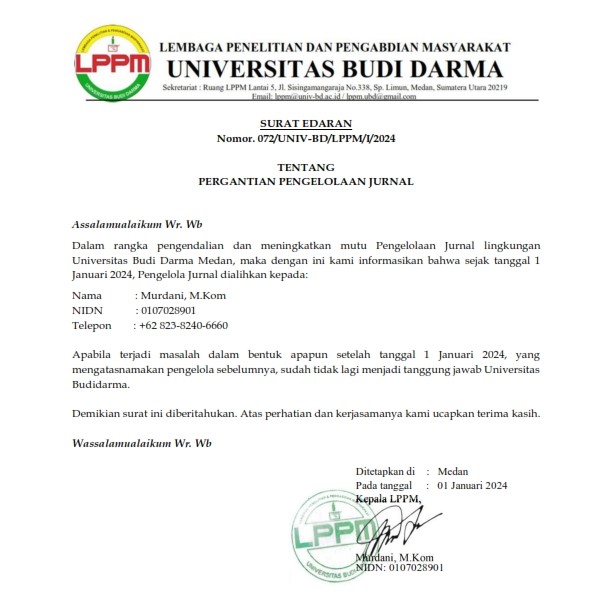Analysis of Online Learning Understanding Patterns at Budi Darma University Using the C5.0 Algorithm
DOI:
https://doi.org/10.30865/ijics.v5i2.3122Keywords:
Data Mining, Corona Virus, Online Learning, Algorithm C5.0Abstract
Online learning is a learning process that is carried out without face to face, but at a distance that utilizes communication and information technology that utilizes the internet. The emergence of the online learning process provides considerable benefits, both for the manager of the information system and for students and students. Currently, the development of online learning is becoming popular among schools and universities. This is caused by the corona virus or what is often called Covid-19. Covid-19 is one of the viruses that first emerged and developed in China, especially in the city of Wuhan. Initially this virus only infects a few people, but in fact this virus can move places or can be transmitted through direct contact with the sufferer. This virus has infected the whole world so this is an international problem that must be addressed. Various efforts have been made, one of which is in the field of education. The closure of schools and colleges is an effort made to break the chain of development of COVID-19, so that the teaching and learning process is carried out online. In this study, an analysis of student satisfaction assessment will be carried out on the online learning process using the existing methods in data mining. Data mining has several algorithms that are used to solve these problems, one of which is the C5.0 algorithm. The result of this study is to find out the results of the satisfaction assessment of online learning during the Covid-19 pandemicReferences
Y. Yuliana, “Corona virus diseases (Covid-19): Sebuah tinjauan literatur,†Wellness Heal. Mag., vol. 2, no. 1, pp. 187–192, 2020, doi: 10.30604/well.95212020.
E. Kuntarto, “Keefektifan Model Pembelajaran Daring dalam Perkuliahan Bahasa Indonesia di Perguruan Tinggi,†J. Indones. Lang. Educ. Lit., vol. 3, no. 1, pp. 53–65, 2017, [Online]. Available: https://www.syekhnurjati.ac.id/jurnal/index.php/jeill/article/view/1820.
M. Sulistiono, “Implementasi Hybrid Learning Menggunakan Aplikasi Edmodo Pada Matakuliah Metode Penelitian Kualitatif,†Elem. J. Ilm. Pendidik. Dasar Islam, vol. 1, no. 1, p. 57, 2019, doi: 10.33474/elementeris.v1i1.2794.
E. Buulolo, Data Mining Untuk Perguruan Tinggi. Yogyakarta: Deepublish, 2020.
E. Prasetyo, Data Mining, Konsep Dan Aplikasi Menggunakan Matlab. Yogyakarta: Andi, 2012.
D. P. Utomo and Mesran, “Analisis Komparasi Metode Klasifikasi Data Mining dan Reduksi Atribut Pada Data Set Penyakit Jantung,†Media Inform. Budidarma, vol. 4, no. 2, pp. 437–444, 2020.
D. P. Utomo, P. Sirait, and R. Yunis, “Reduksi Atribut Pada Dataset Penyakit Jantung dan Klasifikasi Menggunakan Algoritma C5. 0,†Media Inform. Budidarma, vol. 4, no. 4, pp. 994–1006, 2020.
F. Hadi, “Penerapan Data Mining Dalam Menganalisa Pemberian Pinjamana Dengan Menggunakan Metode Algoritma C5 . 0 ( Studi Kasus : Koperasi Jasa Keuangan Syariah Kelurahan Lambung Bukik ),†J. KomTekInfo, vol. 4, no. 2, pp. 214–223, 2017.
R. P. S. Putri and I. Waspada, “Penerapan Algoritma C4.5 pada Aplikasi Prediksi Kelulusan Mahasiswa Prodi Informatika,†Khazanah Inform. J. Ilmu Komput. dan Inform., vol. 4, no. 1, p. 1, 2018, doi: 10.23917/khif.v4i1.5975.
D. Nofriansyah, Konsep Data Mining vs Sistem Pendukung Keputusan. Yogyakarta: Deepublish, 2015.
D. Nofriansyah and G. W. Nurcahyo, Algoritma Data Mining Dan Pengujiannya. Yogyakarta: Deepublish, 2017.
D. Dalbergio, M. N. Hayati, and Y. N. Nasution, “Klasifikasi Lama Studi Mahasiswa Menggunakan Metode C5.0 pada Studi Kasus Data Kelulusan Mahasiswa Fakultas Matematika Dan Ilmu Pengetahuan Alam Universitas Mulawarman Tahun 2017,†Pros. Semin. Nas. Mat. Stat. dan Apl. 2019, vol. 1, no. 1, pp. 36–42, 2019.
A. C. Wijaya, N. A. Hasibuan, and P. Ramadhani, “Implementasi Algoritma C5 . 0 Dalam Klasifikasi Pendapatan Masyarakat ( Studi Kasus : Kelurahan Mesjid Kecamatan Medan Kota ),†Inf. dan Teknol. Ilm., vol. 13, pp. 192–198, 2018.







